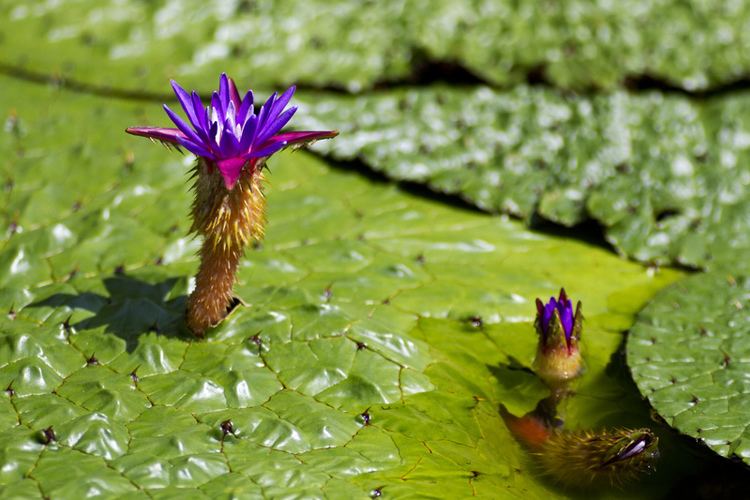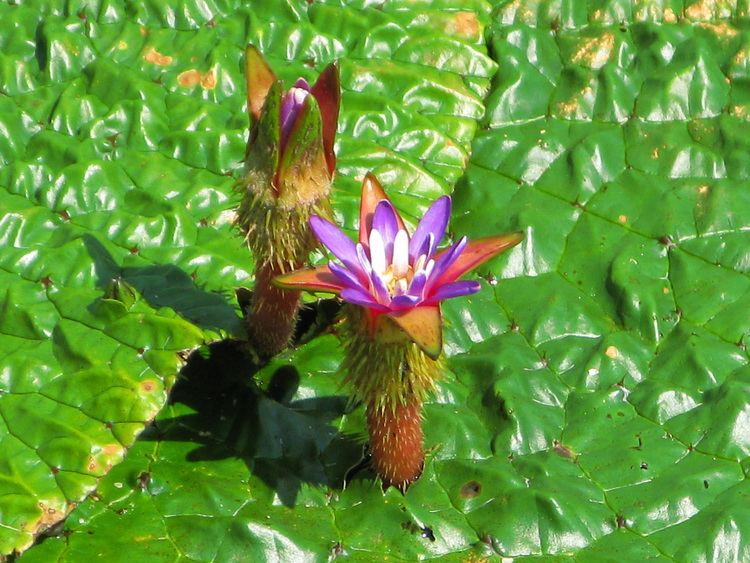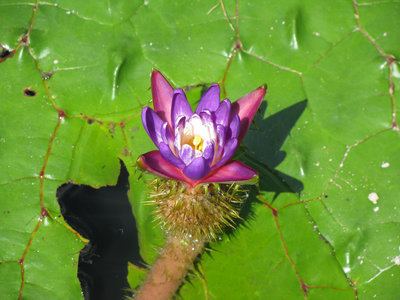Scientific name Euryale ferox Rank Species | Genus EuryaleSalisb. Higher classification Euryale | |
 | ||
Similar Water lilies, Adlay, Euryale, Coix lacryma‑jobi, Chinese yam | ||
makhna euryale ferox
Euryale ferox (also known as Makhana in Hindi and Punjabi, fox nut, foxnut, 'thangjing' in Meeteilon i.e. Meitei, makhana, nikori (in Assamese), Onibas (Onibasu) in Japanese or gorgon nut) is the only extant species in the genus Euryale. It is a flowering plant classified in the water lily family, Nymphaeaceae, although it is occasionally regarded as a distinct family Euryalaceae. Unlike other water lilies, the pollen grains of Euryale have three nuclei.
Contents
- makhna euryale ferox
- Euryale ferox makhana thorny giant waterlily 0915091000dvb snew schedule segment100 36 50 00 50 37
- Growth
- Culinary
- Medicine
- Etymology
- References
Euryale ferox makhana thorny giant waterlily 0915091000dvb snew schedule segment100 36 50 00 50 37
Growth

Euryale is an perennial plant native to eastern Asia, and is found from India- found in Bihar, (local name Makhana) and in Loktak Lake Manipur (local name Thangzing) to Korea and Japan, as well as parts of eastern Russia. It grows in water, producing bright purple flowers. The leaves are large and round, often more than a meter (3 feet) across, with a leaf stalk attached in the center of the lower surface. The underside of the leaf is purplish, while the upper surface is green. The leaves have a quilted texture, although the stems, flowers, and leaves which float on the surface are covered in sharp prickles. Other leaves are submerged. In India, Euryale normally grows in ponds, wetlands etc. Recently the Indian Council of Agricultural Research have developed a technique for the field cultivation of Euryale.
Culinary

The plant produces starchy white seeds that are edible. The plant is cultivated for its seeds in lowland ponds in India, China, and Japan. The Chinese have cultivated the plant for over 3000 years. More than 96,000 hectares of Bihar, India, were set aside for cultivation of Euryale in 1990-1991. The plant grows best in locations with hot, dry summers and cold winters. Seeds are collected in the late summer and early autumn, and may be eaten raw or cooked.

In India, in the northern (Punjab) and western parts of the country, Euryale ferox seeds are often roasted or fried, which causes them to pop like popcorn. These are then eaten, often with a sprinkling of oil and spices. In Mithila culture of Mithilanchal, makhanaknown as Makhaana in Maithili is an auspicious ingredient in offerings to the Goddesses during festivals and is used to show reverence and in cooking, specially to make a porridge/pudding called Kheer of makhana or 'makhaanak kheer' or 'makhaanak payasam' and Makhane Ka Rayta (Makhana Yougurt Blend). Makhhaan along with Paan (betel leaf) and Maachch (fish) is symbolic to Maithil culture.

Evidence from archaeobotany indicates that Euryale ferox was a frequently collected wild food source during the Neolithic period in the Yangtze region, with large numbers of finds coming from the sites of Kuahuqiao, Hemudu, and Tianluoshan. The earliest recorded use of E. ferox was found in Gesher Benot Ya'aqov, Israel, among artifacts of the Acheulean culture 790-750,000 years ago.
Medicine
The seeds of foxnut are used in ayurvedic preparations. In Chinese, the plant is called qiàn shí (simplified Chinese: 芡实; traditional Chinese: 芡實). Its edible seeds are used in traditional Chinese medicine, where they are often cooked in soups along with other ingredients.
Etymology
The name Euryale comes from the mythical Greek Gorgon by the same name. The Soviet Union issued a postage stamp featuring this species.
